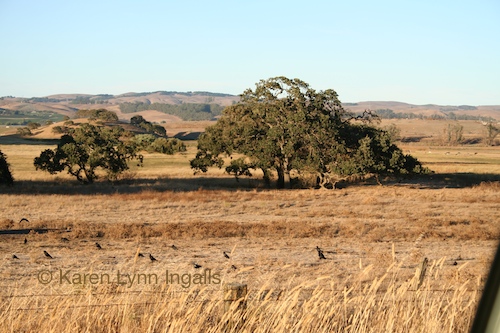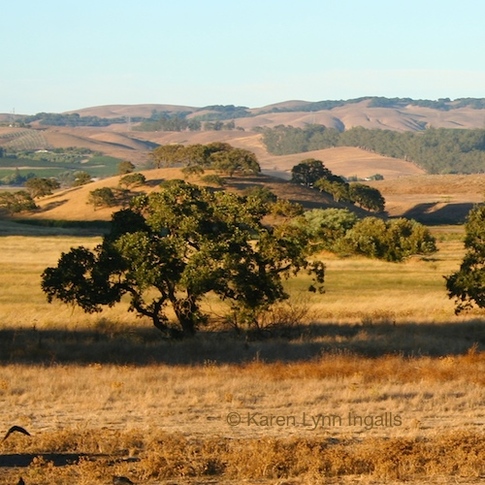|
by Karen Lynn Ingalls  If you look around you, you will never be short of inspiration for your artwork. Interesting buildings in town? Interesting trees in the neighborhood? People sitting and reading the paper in the local coffeehouse? Bring your sketchbook along, and draw what you see. Calistoga City Hall • 5" x 7" • pencil drawing • © Karen Lynn Ingalls Far more often than I'd like to see, new students bring in images of photographs (or paintings) they've found on the internet that they want to copy. Or they tell me about teachers they know who teach students to copy other people's paintings. And then we have the talk about why they should NOT copy someone else's artwork. So, why not just copy? First, there are legal reasons. All visual artists, including photographers, own the copyrights to their own work. They have the choice to license the work for a fee or give permission for their work to be reproduced, if they like. Taking their work is intellectual property theft. And that's not okay. Just because you see it on the internet doesn't mean you can use it without their permission. Artists make a living by selling their work, and copying what they do isn't a compliment — it's taking bread out of their mouths. Apart from the legal issues, there are ethical issues. It's not ethical to copy someone's work and call it yours. If you really, really want to, you can always ask permission. If you're granted permission, ALWAYS credit your original source, and share the results with them. If you want to work from the painting of a long-dead old master, take it in a new direction, but include the artist in the title. You can call it "Homage to Rembrandt" — or whomever. Acknowledge your inspiration. Having had to deal with a violation of my own copyrights, I can tell you from experience it doesn't feel good to find someone has copied your work. It just feels like you've been ripped off.  My inspiration (and source) for this painting? Three palm trees on the side of the road in Palm Springs. I set up my easel across the street, in a rocky field, and painted the trees as the sun set. Plein air painting (painting in the open air) is another great way to find images to paint. Three Palms for Gail • 10" x 8" • acrylic painting on panel • © Karen Lynn Ingalls But, finally, there is the basic question about why you want to paint to begin with. What is your reason for painting? Is it to get in touch with your own creativity? To find joy in the act of creation? If that is why you paint — as it is for most people who want to make art— you cannot be truly creative if you are just copying someone else's work. There are so many things to inspire your work, and to provide you with images to draw and paint. You can, for instance:
Beauty and inspiration are everywhere — you need never be at a loss for something to paint or draw. You will be inspired by the work of other artists, of course! Learn from what you see! When you see work you love, ask yourself, "What is it that I truly love about what I see?" Is it the color palette? The handling of the paint? The subject matter? A particular way of framing the composition? Identify it, whatever it is — and try it out in your OWN work. There is only one YOU in all the world. There is no one else who can say what you have to say, in the way that you can say it. As you develop your skills, you will — and should — try many things. Learn from everything you see! Explore! Practice! Fail (it's okay; it's a necessary part of the process)! Discover! Grow! As you grow, you will find your own visual voice, your style, your spirit, your genius. You will discover who you are as a painter.  I pulled over on the side of the Highway 101 to take this, and a whole series of other photos. It was just before sunset, and I knew I was going to find something in them that I could work with. The individual photos may not look remarkable in themselves... it's what you do with them. See the photograph below to see what I will be painting from. Photo © 2015 Karen Lynn Ingalls If you work from photographs, working from your own photographs is part of the creative process. Trust me; many of my best paintings have come from amazingly bad or mediocre photographs. It's all about what you DO with it. Someone else's great photograph is already art. What more can you say about it visually that it hasn't already said?  Here, you can see the composition I took from the larger photograph above. Saturating the colors a little, so I can see more of what colors are there underneath the drought-dry browns of this California summer, I've arrived at something I'm looking forward to painting. This is all part of my creative process. Photograph © 2015 Karen Lynn Ingalls So here's my advice to my students:
You will find your OWN voice. Allow yourself to be influenced by artwork you love. But your own artwork? Make it truly your own work. And THEN you will be an artist. Trust me: the journey is worth it.
2 Comments
9/13/2015 12:39:56 am
Note that I haven't said anything about fair use in copyright for educational purposes... partly because this blog post is plenty long enough already without getting into further legal stuff. (And I am not a lawyer, nor do I play one on TV.)
Reply
Leave a Reply. |
Karen Lynn IngallsI am a working artist in Napa and Sonoma Counties, in northern California. I paint colorist landscapes of rural California, teach art classes, workshops, and private lessons, live in Calistoga, and have my art studio in Santa Rosa, California. Archives
December 2023
Categories
All
|





 RSS Feed
RSS Feed

